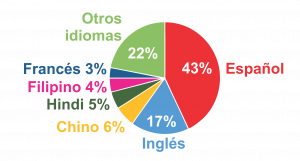Los estudiantes inmigrantes en la educación K-12
Portada
Módulo 1 – Los estudiantes inmigrantes en la educación K-12

Objetivos de aprendizaje:
Objetivos lingüísticos
- Discuss issues related to immigration
- Identify Spanish-speaking countries and nationalities
- Identify members of immediate and extended family
- Refer to completed actions in the past using the preterit
- Talk about ongoing or habitual past actions, and describe past events using the imperfect
- Differentiate between the preterit and the imperfect to refer to past actions and situations
Objetivos culturales y profesionales
- Explore the challenges of student immigrants in the U.S. education system
- Develop knowledge about the history of immigration in the U.S.
- Explore the demographics of the Spanish-speaking communities in the U.S.
- Describe issues related to the learning of English and Spanish by immigrant students and heritage learners
- Explore issues related to newly arrived immigrants and their language abilities
 |
 |
A DISCUTIR
- ¿Conoces a algún inmigrante?
- ¿De dónde vienen los inmigrantes que conoces?
- ¿Por qué crees que la gente emigra de su país para ir a vivir a otros países?
- ¿De qué nacionalidades son la mayoría de los inmigrantes que viven en los Estados Unidos*?
¿Qué lenguas hablan los inmigrantes en sus hogares?

Figura 1. Las lenguas más habladas en casa de los inmigrantes en el año 2017 en los EE. UU.**
* The equivalent of United States in Spanish may be used with (plural noun) or without an article (singular noun). Without an article, the verbs are conjugated in singular (Estados Unidos es), while with an article, they are conjugated in plural (Los Estados Unidos son). This textbook will use the plural form with an article.
**The acronym for USA in Spanish has been historically formatted following different conventions. The Royal Spanish Academy suggests the use of EE. UU. and that is the form that will be used throughout the textbook.
Atribuciones de los medios
- 45909729991_bd0f08a3ca_k © Mani Albrecht is licensed under a Dominio público license
- MaleconHavana © Richard is licensed under a CC BY (Atribución) license
- Students at National Park © NPS is licensed under a Dominio público license
- lenguas más habladas en casa © Giovanni Zimotti adaptado por https://www.pewresearch.org/hispanic/2019/06/03/facts-on-u-s-immigrants/ is licensed under a CC BY (Atribución) license

